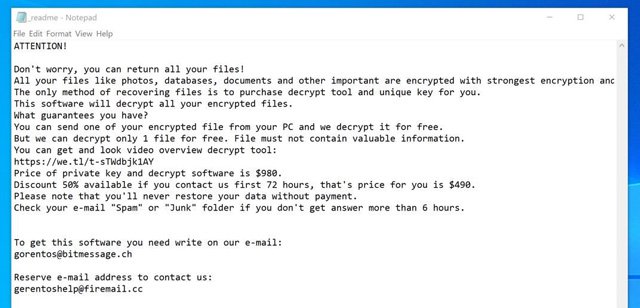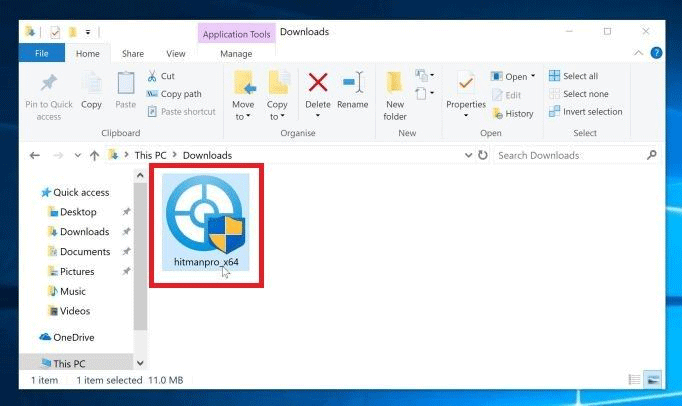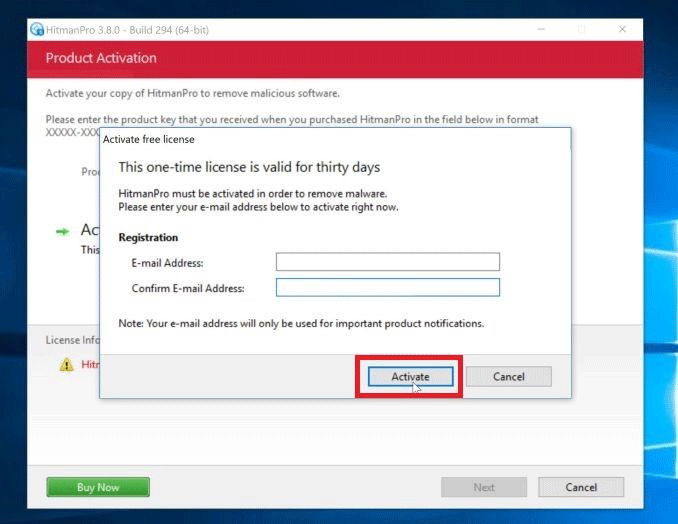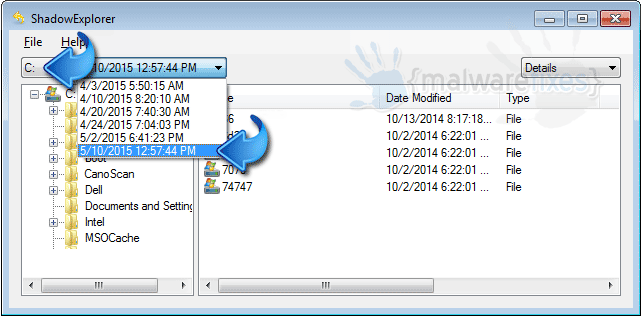How to delete ransomware creates a .boot file
If the image, document, or file is encrypted using the Boot extension, it means your computer has been infected with ransomware STOP (DJVU).
Ransomware STOP (DJVU) encrypts personal documents on the victim's computer, then displays a message providing data decryption if paying with Bitcoin. Instructions for decoding the file are displayed in the _readme.txt file. This article will guide you how to delete ransomware to create a .boot file.
Warning: This guide will help you to remove ransomware from creating a .boot file, but it will not help recover the file. You can try ShadowExplorer or free file recovery software to recover data.
Instructions to remove ransomware create .boot file extension
- 1. How does Ransomware create a .boot file? How do I get to your computer?
- 2. What is Ransomware creating a .boot file?
- 3. Is your computer infected with ransomware creating a .boot file?
- 4. Is it possible to decrypt files encrypted with ransomware to create .boot files?
- 5. How to remove ransomware to create .boot file extension
- Use Malwarebytes to remove ransomware and create a .boot file
- Use HitmanPro to scan for unwanted malware and programs
- Recover files encrypted with ransomware to create .boot file with recovery software
- 6. How to prevent a computer from being infected with ransomware to create a .boot file extension
1. How does Ransomware create a .boot file? How do I get to your computer?
Ransomware creates bootable files distributed via email that contain ransomware-infected attachments or enters by exploiting holes in the operating system and installed software.
Cybercriminals spam email with fake information to trick you into sending messages from shipping companies like DHL or FedEx. The email notifies you that you have an order, but for some reason it cannot be sent to you. Or sometimes, an email notifying you of the order you have made. Either way, it makes people curious and open the attachment (or click on the link embedded in the email). As a result, your computer is infected with ransomware creating a .boot file.
Ransomware creates a .boot file that can also be hacked by hacking Remote Desktop Services (RDP) ports. Attackers scan systems running RDP (TCP port 3389) and then perform brute force attacks on system passwords.
2. What is Ransomware creating a .boot file?
Ransomware Series : STOP (DJVU) ransomware
Extensions : Boot
Ransom file : _readme.txt
Ransom : From 490 USD to 980 USD (in Bitcoin)
Contact : gorentos@bitmessage.ch, gerentoshelp@firemail.cc or @datarestore on Telegram
Ransomware creates a .boot file that restricts access to data by encrypting files. It then tried to blackmail the victim by requesting a ransom in Bitcoin cryptocurrency to regain access to the data. This ransomware targets all versions of Windows including Windows 7, Windows 8 and Windows 10. When first installed on the computer, this ransomware will create an executable file named randomly in the% AppData% folder. or% LocalAppData%. This executable will launch and start scanning all drive letters on your computer for encrypted data files.
Ransomware creates a .boot file that looks for files with specific file extensions for encryption. The files it encrypts are usually important documents and files such as .doc, .docx, .xls, .pdf, etc. When it is found, it will change the file extension to Boot so that it cannot be opened anymore. .
Below is a list of file extensions that this ransomware targets:
.sql, .mp4, .7z, .rar, .m4a, .wma, .avi, .wmv, .csv, .d3dbsp, .zip, .sie, .sum, .ibank, .t13, .t12, .qdf , .gdb, .tax, .pkpass, .bc6, .bc7, .bkp, .qic, .bkf, .sidn, .sidd, .mddata, .itl, .itdb, .icxs, .hvpl, .hplg,. hkdb, .mdbackup, .syncdb, .gho, .cas, .svg, .map, .wmo, .itm, .sb, .fos, .mov, .vdf, .ztmp, .sis, .sid, .ncf, .menu, .layout, .dmp, .blob, .esm, .vcf, .vtf, .dazip, .fpk, .mlx, .kf, .iwd, .vpk, .tor, .psk, .rim, .w3x , .fsh, .ntl, .arch00, .lvl, .snx, .cfr, .ff, .vpp_pc, .lrf, .m2, .mcmeta, .vfs0, .mpqge, .kdb, .db0, .dba,. rofl, .hkx, .bar, .upk, .das, .iwi, .litemod, .asset, .forge, .ltx, .bsa, .apk, .re4, .sav, .lbf, .slm, .bik, .epk, .rgss3a, .pak, .big, wallet, .wotreplay, .xxx, .desc, .py, .m3u, .flv, .js, .css, .rb, .png, .jpeg, .txt, .p7c, .p7b, .p12, .pfx, .pem, .crt, .cer, .der, .x3f, .srw, .pef, .ptx, .r3d, .rw2, .rwl, .raw, .raf , .orf, .nrw, .mrwref, .mef, .erf, .kdc, .dcr, .cr2, .crw, .bay, .sr2, .srf, .arw, .3fr, .dng, .jpe,. jpg, .cdr, .indd, .ai, .eps, .pdf,. pdd, .psd, .dbf, .mdf, .wb2, .rtf, .wpd, .dxg, .xf, .dwg, .pst, .accdb, .mdb, .pptm, .pptx, .ppt, .xlk, .xlsb, .xlsm, .xlsx, .xls, .wps, .docm, .docx, .doc, .odb, .odc, .odm, .odp, .ods, .odt
When the file is encrypted with the Boot extension, this ransomware will create the file _readme.txt, explaining how to retrieve the file and ask for a ransom in each folder where the file is encrypted and on the Windows desktop. These files are placed in every encrypted file folder and contain information on how to contact cyber criminals to retrieve the files.
When the scan is completed, it will also delete all Shadow Volume Copy on the infected computer so that it cannot be used to recover encrypted files.
3. Is your computer infected with ransomware creating a .boot file?
When the computer is infected with this ransomware, it scans all drive letters to find the target file type, encrypts them and then adds the Boot extension. When these files are encrypted, you will not be able to open them with normal programs. When this ransomware completes encrypting the victim's file, it also displays a file containing instructions on how to contact a cyber criminal (gorentos@bitmessage.ch or gerentoshelp@firemail.cc).
Here is the ransom notification in the _readme.txt file:

4. Is it possible to decrypt files encrypted with ransomware to create .boot files?
Unfortunately, the answer is no. You cannot recover files that are encrypted with ransomware, create a .boot file, because you need a private key to unlock encrypted files, which only cyber criminals have.
Do not pay to recover files. Even if you pay for them, there's no guarantee you'll get your file access back.
5. How to remove ransomware to create .boot file extension
Warning: It is important to note that with this approach you will lose your files. Malwarebytes and HitmanPro can detect and remove this ransomware but these programs cannot recover documents, photos or files. Therefore consideration should be given to this process.
Use Malwarebytes to remove ransomware and create a .boot file
Malwarebytes is one of the most popular and most used anti-malware software for Windows. It can kill many types of malware that other software may miss.
Refer to Effective virus removal with Malwarebytes Premium software to know how to use this malware.
Use HitmanPro to scan for unwanted malware and programs
HitmanPro is a scanner that implements a unique cloud-based method to scan for malware. HitmanPro scans the behavior of active files and files in locations where malware normally resides to perform suspicious activities. If a suspicious file is found to be unknown, HitmanPro will send it to the cloud for two of the best antivirus tools Bitdefender and Kaspersky to scan.
Although HitmanPro is shareware, it costs $ 24.95 for a year with a computer, but practically unlimited scanning. Limited only if you need to remove or quarantine the malware detected by HitmanPro on the system and then you can activate the 30-day trial to clean.
Step 1. Download HitmanPro
- Download HitmanPro for 32-bit Windows
- Download HitmanPro for 64-bit Windows
Step 2. Install HitmanPro
After the download is completed, double click 'hitmanpro.exe' (for 32-bit Windows) or 'hitmanpro_x64.exe' (for 64-bit Windows) to install the program on your computer. Usually, the downloaded file will be saved to the Downloads folder.

If the UAC message appears, click Yes .

Step 3. Follow the instructions on the screen
When starting HitmanPro, you will see the boot screen as shown below. Click the Next button to perform a system scan.


Step 4. Wait for the scan to complete
HitmanPro will start scanning your computer for malicious programs. This process may take several minutes.

Step 5 . Click on Next
When HitmanPro finishes scanning, it will display a list of all malware found. Click Next to remove the malicious program.

Step 6 . Click on Activate free license
Click the Activate free license button to start your free 30-day trial and remove the malicious file from your computer.


When the process is complete, you can close HitmanPro and continue the rest of the tutorial.
Recover files encrypted with ransomware to create .boot file with recovery software
In some cases, it is possible to restore an earlier version of an encrypted file using Boot Restore or other unusual recovery software that contains a shadow copy of the file.
Below is a tool to decode encrypted STOP ransomware files, created by experts on the Bleeping Computer security forum, you can try to see if you can retrieve your data. If this doesn't work, try other solutions below.
https://download.bleepingcomputer.com/demonslay335/STOPDecrypter.zip Option 1: Recover encrypted files with ransomware and create .boot file extensions with ShadowExplorer
Ransomware creates a .boot file extension that will attempt to delete all shadow copies when it first launches any executable file on the computer after being infected with ransomware. Fortunately, ransomware cannot eliminate shadow copies, so you should try to recover your files using this method.
Step 1 . Download ShadowExplorer by following the download link below.
- Download ShadowExplorer for Windows
Step 2. Install the program with default settings.
Step 3. The program will run automatically after installation. If not, double click on the ShadowExplorer icon.
Step 4 . You can see the drop down list at the top of the dashboard. Select the drive and the most recent shadow copy you want to recover before ransomware gets infected with a .boot file extension.

Step 5 . Right-click on the Drive , Folder or File you want to recover and click on Export .
Step 6 . Finally, ShadowExplorer will notify you where you want to save the restored file copy.
Option 2: Recover encrypted files with Boot extension with file recovery software
When the file is encrypted, this ransomware first creates a copy of them, encrypts the copy and then deletes the original. Therefore, there is a small chance you can use file recovery software to recover deleted files such as Recuva, EaseUS Data Recovery Wizard Free, R-Studio.
Option 3: Use the Previous Versions tool of Windows
Windows Vista and Windows 7 have a feature called Previous Versions. However, this tool can only be used if the restore point was made before ransomware infection created the .boot file extension. To use this tool and restore ransomware-infected files, follow these steps:
Step 1 . Open My Computer or Windows Explorer .
Step 2. Right-click the infected file or folder ransomware. From the drop-down list, click Restore previous versions .
Step 3 . A new window will open showing all backups of the files and folders you want to restore. Select the appropriate file and click Open , Copy or Restore . Restore selected files to overwrite existing encrypted files on the computer.
6. How to prevent a computer from being infected with ransomware to create a .boot file extension
To prevent your computer from ransomware creating a .boot file extension, you need to install an antivirus program on your computer and always back up personal documents. You can also use a program called HitmanPro.Alert to prevent file encryption malware from running on the system.
I wish you successful implementation!
You should read it
- Instructions for using HitmanPro.Kickstart to boot the infected computer
- How to remove Moba ransomware from the operating system
- What is Ransomware CryptoWall 4.0? How to clean up Ransomware CryptoWall 4.0?
- How to get rid of root virus * .OSIRIS - Ransomware Locky?
- What is Ransomware Screen Locker? How to remove?
- How to remove ransomware .Mogera Virus File
- Ransomware can encrypt cloud data
- STOP - Ransomware is the most active in the Internet but rarely talked about
May be interested
- New variant of ransomware Arena Crysis appeared
 researcher michael gillespie has discovered a new variant of ransomware crysis / dharma that adds the .arena extension to the encrypted file.
researcher michael gillespie has discovered a new variant of ransomware crysis / dharma that adds the .arena extension to the encrypted file. - Detection of a new ransomware strain targeting the Windows search engine
 a ransomware attack begins when the victim receives an executable file containing malicious code via email.
a ransomware attack begins when the victim receives an executable file containing malicious code via email. - There is a tool to decrypt the ransomware that specializes in attacking businesses
 this new ransomware is still in development.
this new ransomware is still in development. - Edit the Boot.ini file in Windows XP
 windows xp has just been updated but after restarting, there is an error message invalid boot.ini or windows could not start because the following file is missing or corrupt: windowssystem32hall.dll, what will you do? do you want to re-select the first boot-up operating system in your multi-operating system?
windows xp has just been updated but after restarting, there is an error message invalid boot.ini or windows could not start because the following file is missing or corrupt: windowssystem32hall.dll, what will you do? do you want to re-select the first boot-up operating system in your multi-operating system? - General guidelines for decoding ransomware
 in this guide, tipsmake.com will try to help unfortunate readers infected with ransomware and encrypted files on the computer.
in this guide, tipsmake.com will try to help unfortunate readers infected with ransomware and encrypted files on the computer. - What is Ransomware Task Force (RTF)?
 ransomware has become one of the top security threats in the past three years. the first ransomware strain and one of the worst nightmares in the history of global cybersecurity - wannacry - was discovered in may 2017.
ransomware has become one of the top security threats in the past three years. the first ransomware strain and one of the worst nightmares in the history of global cybersecurity - wannacry - was discovered in may 2017. - New ransomware detection not only encrypts files but also helps 'clean up' the system
 rxomware vxcrypter is the first ransomware in the world that not only encrypts the victim's data but also helps clean up their computers by deleting duplicate files on the system.
rxomware vxcrypter is the first ransomware in the world that not only encrypts the victim's data but also helps clean up their computers by deleting duplicate files on the system. - [Infographic] 7 effective ways to protect businesses from Ransomware
![[Infographic] 7 effective ways to protect businesses from Ransomware](https://tipsmake.com/img/no-image-80-80.png) how to protect your business from ransomware? join tipsmake.com to follow the article to find the answer.
how to protect your business from ransomware? join tipsmake.com to follow the article to find the answer. - How to decode ransomware InsaneCrypt (Everbe 1.0)
 ransomware insanecrypt or everbe 1.0 is a ransomware family based on an open source project. this ransomware family is distributed through spam and hacked into remote desktop services, but this is not yet confirmed.
ransomware insanecrypt or everbe 1.0 is a ransomware family based on an open source project. this ransomware family is distributed through spam and hacked into remote desktop services, but this is not yet confirmed. - Instructions for using HitmanPro.Kickstart to boot the infected computer
 hitmanpro.kickstart allows you to boot your computer from a usb flash drive to remove ransom malware. because you cannot start your computer in the usual way, surfright developed hitmanpro.kickstart that is easy to use for ordinary users. all you need to do is boot your system with the help of the hitmanpro.kickstart usb flash drive and it's ready to use.
hitmanpro.kickstart allows you to boot your computer from a usb flash drive to remove ransom malware. because you cannot start your computer in the usual way, surfright developed hitmanpro.kickstart that is easy to use for ordinary users. all you need to do is boot your system with the help of the hitmanpro.kickstart usb flash drive and it's ready to use.







![[Infographic] 7 effective ways to protect businesses from Ransomware](https://tipsmake.com/data/thumbs_80x80/[infographic]-7-effective-ways-to-protect-businesses-from-ransomware_thumbs_80x80_RmVUGjsQC.jpg)


 How to detect and remove malware Agent Smith on Android
How to detect and remove malware Agent Smith on Android How does malware target illegal streams?
How does malware target illegal streams? Review IObit Malware Fighter 7 and give you the 100 key Pro version
Review IObit Malware Fighter 7 and give you the 100 key Pro version How to remove ransomware .Mogera Virus File
How to remove ransomware .Mogera Virus File Learn about polymorphic malware and super polymorphism
Learn about polymorphic malware and super polymorphism